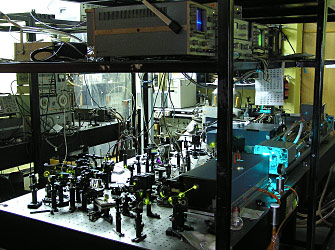Current development of diagnostic and information technologies is heavily dependent on the quickly expanding area of application of those effects where the laws of quantum mechanics play the fundamental role. One of the themes, which are studied extensively by the international scientific community, is the use of quantum interference in atomic and/or photon systems for data computing processes, telecommunication, cryptography, ultra-precise measurements, development of the new-generation frequency standards, etc.
 |
|
The stand for experiments in the field
of quantum and optical information technologies |
|
The development of this research field at IAP is connected with pioneering studies of the effects of quantum-transition interference, in particular, coherent population trapping (CPT), in optically thick resonant-absorbing media. These works have been performed in the 1980s—1990s by Ya. I. Khanin,
O. A. Kocharovskaya and their team. IAP has obtained several important results, which play the definitive role in this field in the entire world. It includes the prediction of the phenomena of electromagnetically induced transparency (EIT) and lasing without inversion (LWI). The foundation for laser Mossbauer spectroscopy of nuclear gamma transitions has been laid, and the methods for taking into account the influence of the coherent field on the character of atomic relaxation have been developed. The realization schemes of various versions of quantum interference effects and their analogs in systems with collective degrees of freedom have been proposed, specifically, analogs of CPT and EIT for ensembles of free electrons in the magnetic field, acoustically induced transparency in an ensemble of two-level atoms, and parametrically induced transparency in an optically dense three-level medium (A. G. Litvak, O. A. Kocharovskaya,
E. V. Radionychev, and M. D. Tokman). The experiments of IAP researchers in this field were connected with high-accuracy magnetometry (including non-contact CPT magnetometry of fusion plasma),
RF-induced transparency for the resonant laser field and studies of CPT and EIT in the crystals doped with ions of rare-earth metals (the team of R. A. Akhmedzhanov). The latter research field served as the basis for the current studies in the field of physical elements of quantum data and telecommunication technologies.
Currently, IAP implements an experimental program for the development of solid-state components of quantum data and telecommunication systems. The following steps have been made, which are necessary for the development of a quantum computer (a system of coupled qubits) and quantum data transmission lines (chains of quantum repeaters):
• spectrum selection (isolation of a group of particles with nonuniform line widths being narrower than superfine splitting of operation levels);
• manipulation of populations of supe-fine (qubit) levels;
• a controllable shift of the absorption line of one spectrally isolated group of ions during excitation of another.
 |
Experimental realization quantum memory based on the photon echo in an atomic frequency comb. Left: atomic frequency comb on the optical transition 3H4(1)—1D2(1) in a Pr3+:LaF3 crystal. Right: the photon echo signal (red line) and the pulse transmitted through the medium in the absence of an atomic frequency comb (black line) |
It has been shown that the EIT effect can be amplified significantly by using a specially prepared (selected with respect to the frequency in the non-uniform circuit) ensemble of particles. The quantum memory based on the spectral array of ions of rare-earth metals, which are embedded in a non-organic crystal, has been developed.
In theoretical fields, in the recent years IAP researchers proposed the scheme of generation of correlated quantum states of multiple-frequency photons in optically dense ensembles of three-level atoms, which are controlled by coherent optical pumping. The technique of simulating the dissipative qubit dynamics by the quantum Monte-Carlo method has been developed: a console-based cross-platform application has been produced, which supports parallel computations and is realized in cluster systems.
Another promising field where the studies of quantum interference effects in solid media can be developed, is the generation of supershort pulses of electromagnetic radiation in a wide frequency band, from the IR to the X-ray range. The approach proposed in IAP is based on the use of resonant interaction of the electromagnetic radiation with atomic transitions under the conditions, when the controllable nonresonant laser field performs spatio-temporal modulation of frequencies and spectral line widths of quantum transitions due to the Stark effect or Zeeman effect, as well as tunnel ionization of atoms from excited states.
It is found possible to form both a sequence of pulses and single pulses with durations up to 700 as at a wavelength of 122 nm in the medium of hydrogen atoms, as well as up to 60 as at a wavelength of 13.5 nm (i.e., about two field periods) in the medium of Li2+ ions.
|
|
Efficient conversion of monochromatic pumping radiation to polychromatic radiation with correlated components in a dense medium of three-level atoms |
Resonant formation of a single pulse in the medium of hydrogen atoms. The inset shows the scheme of modulations in frequencies and transition widths under the action of the guiding field |





